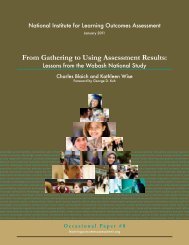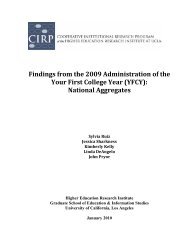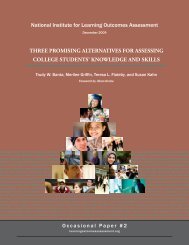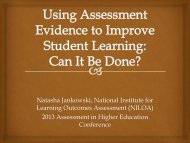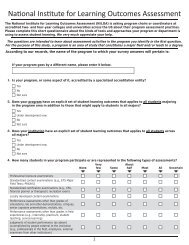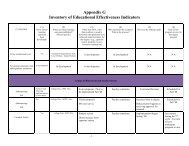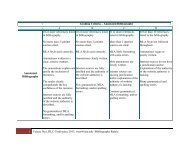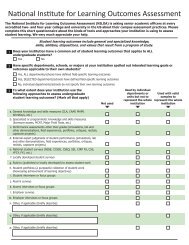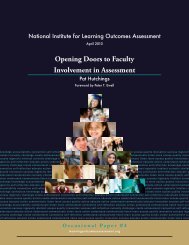Capella University - National Institute for Learning Outcomes ...
Capella University - National Institute for Learning Outcomes ...
Capella University - National Institute for Learning Outcomes ...
- No tags were found...
Create successful ePaper yourself
Turn your PDF publications into a flip-book with our unique Google optimized e-Paper software.
tive’s data working group, which developed the template that participating institutions use to trackand report results.In addition to participating in external initiatives such as TbD, <strong>Capella</strong> developed an entire websitededicated to reporting assessment results. <strong>Capella</strong> <strong>Learning</strong> & Career <strong>Outcomes</strong>, or <strong>Capella</strong> Results,provides comprehensive, in-depth data and results of program learning outcomes and is “progressivein publishing program-level in<strong>for</strong>mation on both expected and actual learning outcomes.” On thewebsite there are video explanations of reports, detailed in<strong>for</strong>mation on how to navigate and understandinteractive graphs, and results <strong>for</strong> individual programs and specializations on learning and careeroutcomes. <strong>Learning</strong> outcomes transparency is described as “at its most simple <strong>for</strong>m, the establishmentof program outcomes, measuring learners’ achievement, or demonstration of those outcomes, andthen publishing the results externally.” A press release states that <strong>Capella</strong> Results “enables the public,including prospective students, employers, and policymakers, to assess the value of a <strong>Capella</strong> educationby providing detailed measurement of student outcomes—the actual skills and knowledge <strong>Capella</strong>students obtain—as well as graduation and career success rates.” The importance of publicly sharingresults was expressed by the Provost: “It shows those internally and externally that we really mean it,saying you know we are going to measure learning outcomes, continuously improve, and make it allpublic. But it also gives people in<strong>for</strong>mation that allows them to make good choices.”Using Evidence of Student <strong>Learning</strong><strong>Capella</strong> uses different types of assessment results and indirect indicators of student learning in numerousways. As stated on its website, <strong>Capella</strong>’s enrollment counselors use the data to help prospective learnerschoose degree programs; advisors and career counselors use the results to guide learners in career explorationand planning; and faculty use the results to improve academic programs, update curriculum,and generally improve student learning and the career success of graduates. <strong>Capella</strong> is committed tosupporting the use of assessment results within the institution and even has a university policy on theuse of assessment data. Assessment results are included in the process <strong>for</strong> course revision, all of thecurriculum alignment processes, program review, and the identification of priorities. The Directorof Curriculum and Instructional Support claimed, “We use assessment results every day in all of ourdecision making. We are a data-driven institution; it’s really embedded throughout the organization.”However, another administrator cautioned that the use of assessment results is a work in progress, inwhich “there are many different ways that assessment data are trying to be utilized and I think we’restill trying to mature in our decision-making models.” On the general use of assessment results, Dr.Offerman explained,We are interested in using data and converting it rapidly to useful or actionable in<strong>for</strong>mationthat we then give to faculty, advisors, and most importantly directly to learners. Our vision isnot that we are merely assessing learning but that we are assessing it and using that in<strong>for</strong>mationto understand whether or not programs are delivering what they are supposed to, coursesare delivering what we claim they are, and that learners are actually achieving what they needto succeed. Thus, what began as an ef<strong>for</strong>t to say we are outcomes-based has become what wewould call now action analytics.Two examples of the use of assessment results to make improvements to student learning are presentedbelow. One is from a business program and the other is from a psychology department. In the firstexample, a faculty chair in business examined the results of program outcomes <strong>for</strong> learners who completedthe program capstone course and found that on one of the outcomes, learners were per<strong>for</strong>ming belowwhat he regarded as the minimum threshold. Through the curriculum maps and alignments linkinglearning activities in individual courses to program outcomes in the capstone, he was able to identifyacross the entire program which courses had the strongest alignment to the outcome in question. From<strong>National</strong> <strong>Institute</strong> <strong>for</strong> <strong>Learning</strong> <strong>Outcomes</strong> Assessment | 6



